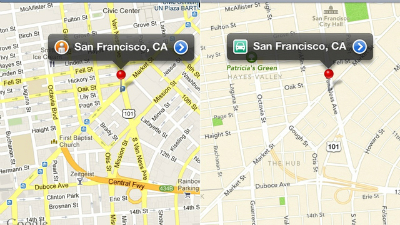September 19 is one of the biggest days in an Apple fan’s calendar–at least lately–as it’s going to mark the release of iOS 6. Since we’ve been taking a closer look at navigation apps, especially those dealing with the iPhone 5 and the iOS platform, recently, there’s very good news afoot as Apple’s planning a turn by turn navigation update.
It had been a topic of discussion for some time, especially among those who had noticed that Google and Apple were somewhat on the outs, and Google Maps, as a result, had been thrown out, out of the future iOS lineup. It had been the subject of speculation for some time that Apple would instead bring out its own branded navigation app, and that appears to be just the case with the upcoming–later this week upcoming–Apple Maps.

The bad news, right off, is that some countries won’t be getting this new map functionality right off the bat. Recently it was discovered that Australia, which was though to not be getting hands on the new application, actually would get it. By all currently available information, however, that has now changed, and Australia will be joining a host of countries slated to get the turn by turn navigation capability of Apple Maps in October. So, while there will be a bit of a delay, getting the package on a “better late than never” sort of basis is better news than they’d likely thought they’d gotten less than a week ago.
The question here, of course, will be if Apple’s mapping software is a match for the Google mapping software which Apple had used for quite some time. The early indications suggest that this may actually be a problem for Apple, in that Apple’s house-built app–built, of course, with some help from TomTom among others–is actually a step down in terms of technological prowess from that of Google. Google has actually been working on mapping software since 2005, when they bought out Where 2 Technologies. Apple didn’t actually get into the mapping game until 2009–four years later–when they bought Placebase. The result is a system that Apple is actually unfamiliar with, and a process that will look quite a bit worse when compared against the Google Maps joy that Apple users had previously held.

The question will be, as a result, twofold: Will Apple users be sufficiently patient to wait for Apple to play catch-up? Additionally, will they even care that much in the first place? Sure, the Maps application is just a very small part of the overall Apple picture, but with so many other mapping applications out there–including the variety of them we’ve been talking about for the last few weeks–maybe people won’t be inclined to wait for Apple to get its act together.
Still though, there’s a lot else going on in the Apple portfolio, which is similar to the concept of cloud-based telephony in general. Features like reporting and analytics and meet-me conferences may not help users get to where they want, or need, to be, but they certainly do help in other vital ways.
The end result here is that Apple may have a significant problem right out of the gate with its upcoming release of Apple Maps, but then again, the problem may not be all that significant after all.
Related keywords: iOS, cloud-based telephony, Google Maps, mapping software